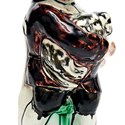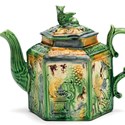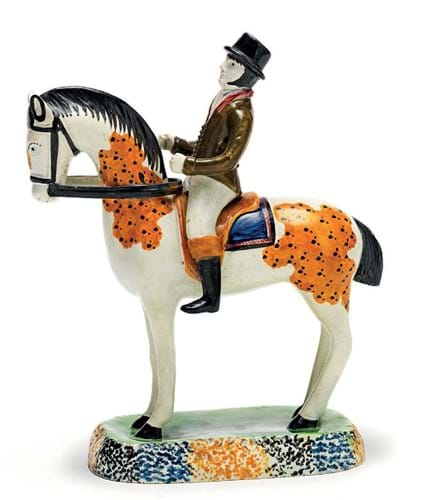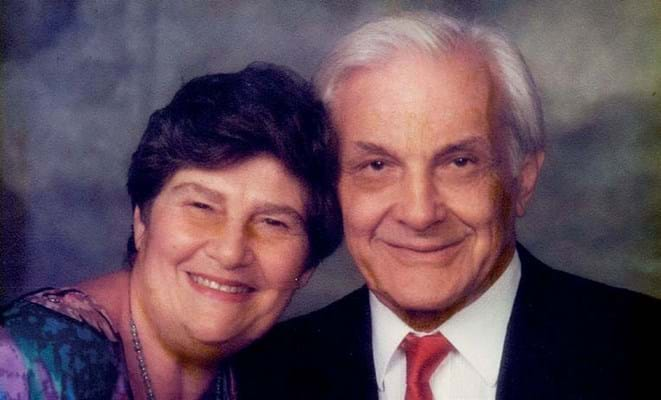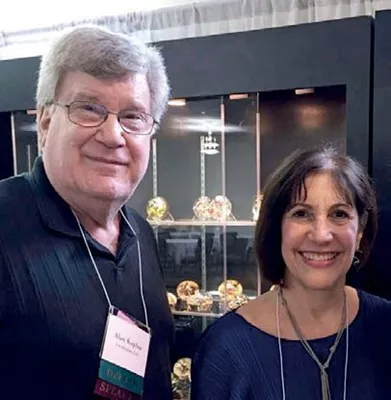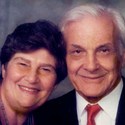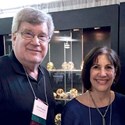A stock sale in New York was perhaps the easy option. Instead, 17 years since the dealership had last exhibited in London, Bonhams (25/20/12% buyer’s premium) chose to ship the firm’s substantial collection to Knightsbridge for sale on July 11.
John Sandon, director of European ceramics and glass, explained the reasoning. “The market has changed – perhaps more in New York than it has over here. The Kaplans were in some ways the last of a breed. The decision to sell in the UK proved right, with most of the pieces sold to British buyers at encouraging levels.”
The contents of a 469-lot catalogue titled Transatlantic Taste epitomised traditional post-war American collecting.
By the mid-1970s Kaplan led New York in six specialist spheres: pre-Victorian British pottery and early English porcelain, Russian and Norwegian enamels, Wedgwood Fairyland lustre, Stourbridge and French art glass and antique and contemporary paperweights.
Leo Kaplan was deemed a world authority on French and American paperweights, with many of the pieces in the Corning Museum of Glass purchased through the gallery.
All except the enamels formed part of Bonhams’ sale – with the ceramics (256 lots of British pottery and 40 lots of English porcelain) making up much the stronger suit.
Sensitive estimates
The auctioneers managed expectations with reserves sensitive to market realities, but it helped too that, from Wood family models to Wedgwood dry bodied wares, these were well-chosen examples of classic British pottery.
“Not everything was free of damage but these were good-looking examples that displayed well. Offered at the right kind of estimates, that is what people seem to want,” said Sandon. The selling rate was over 90%.
The selection of Whieldon-type wares – perhaps the best group at auction since the Sampson Horne sale in 2010 – was particularly well-received.
Sold at the top end of a £3000-5000 estimate was a hexagonal teapot and cover c.1765-70 with chinoiserie vignettes borrowed from George Edwards’ and Matthias Darly’s New Book of Chinese Designs, first published in London in 1754.
Similar wasters have been excavated at Thomas Whieldon’s factory site in the area of Staffordshire once known as Fenton Vivian. Another teapot of this type was sold by Bonhams in December 2012 as part of the Tom Walford collection for £3000.
A Staffordshire agate ware teapot featuring three paw feet with lion mask terminals and a lion finial sold for £3200 was perhaps also from Fenton Vivian. A hexagonal teapot formed as crisply moulded vine leaves and stems which made £4800 (estimate £2000-3000).
The selection of toby jugs mixing relatively common models with occasional rarities performed robustly – boding well for an important private collection Bonhams will offer for sale in November.
A pearlware Dick Whittington jug, c.1785 sold for £4500 (estimate £1500-3000). Unusually for a toby jug, this 6in (15cm) model was created without a handle with the figure probably based upon the parson in the well-known Tithe Pig group. Here he holds a cat instead of a pig or baby.
It is deemed exceptionally rare, although there were two in the sale: another with more substantial condition issues took £2200.
A large number of Yorkshire Prattware models, c.1810-20 were topped at £4500 (estimate £2000- 3000) by the 9in (23cm) figure of a horse and rider of a type associated with an as-yet undetermined factory dubbed the ‘Pottery that used a Large Crown Mark’. Two related models were sold by Bonhams in May 2013 for £3300 and £3000 so again this appeared a relatively strong price.
A pair of Prattware elephants, each carrying a Gothic turret to be used as a money box, sold at the top end of a £3000-5000 estimate. When sold by Phillips in 1994, they were provenanced to the family of Miss Lucy T Aldrich, sister of the American ambassador to London, 1852-56.
Toulouse the ‘repairer’
English porcelain led the sale courtesy of a £13,000 bid (estimate £8000-12,000) for a pair of Worcester hexagonal form vases and covers decorated with applied floral garlands, female mask handles, lattice work and vibrant enamelling. The 15in (39cm) pair, sold at Phillips in the late 1980s, had a provenance to the Perth (Western Australia) collector Harold Schenberg.
The ‘T’ stamp on the footrim is the mark of John Toulouse, an elusive figure working as a ‘repairer’ for Dr Wall’s Worcester factory c.1770-72 who is likely to have been the modeller who supervised the assembly of these vases.
With remarkably little damage, they were in much better condition than the pair from the Zorensky collection sold at Bonhams twice: in February 2005 for £13,000 and again in November 2016 for £6500. The single example in the V&A had been purchased by Lady Charlotte Schreiber from London dealer Wareham for £60 in November 1872, when it was thought to be Bow porcelain.
Closely related ‘frill vases’ were indeed made by Toulouse at Bow and later at Bristol. A single hard paste vase from William Cookworthy’s Bristol concern c.1772 decorated with formal flower, insects and birds in flight, sold at £4000 (estimate £2000-3000).
Factfile: Leo Kaplan Ltd (1969-2018)
- The son of Russian immigrants, Leo Kaplan (1917-2013) was born and raised in a modest home in the Bronx.
- He worked in the lumber business but weekends spent ‘antiquing’ with his wife Ruth in the post-war era led to a first antiques fair (an outdoor flea market) in 1965 and, in 1969, the $400-a-month rent on a shop on Madison Avenue.
- Leo Kaplan Ltd later enjoyed regular success at the International Ceramics Fair in London (exhibiting from 1989 until 2001) and at New York Ceramics Fair since its inception in 2000.
- The firm, latterly run by their children Alan Kaplan and Susie Jacobson, opened six days a week in East 57th Street (its sixth premises in downtown Manhattan) until earlier this year. The decision to close was bittersweet. Jacobson wrote: “The landlord has made the decision a bit easier as the cost of doing business in New York City has become prohibitive.” Alan plans to continue as a private dealer.





